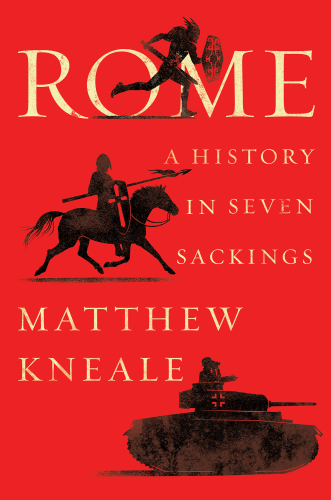
Rome
A History in Seven Sackings
کتاب های مرتبط
- اطلاعات
- نقد و بررسی
- دیدگاه کاربران
نقد و بررسی

December 1, 2017
Whitbread Book of the Year Award-winning novelist Kneale, who studied modern history at Oxford and now lives in Rome, takes a distinctive approach to the city's history: he highlights the invasions that have shaped the city from ancient times until 1943. "A masterpiece of pacing and suspense" (London Sunday Times).
Copyright 2017 Library Journal, LLC Used with permission.

March 19, 2018
Kneale (Passengers) stumbles in his attempt to plumb the mystique of the Eternal City in this panoramic and deeply researched account of Roman history, told through the city’s seven sackings at the hands of Gauls, Goths, Nazis, and other barbarian hordes. Early in the process of writing, Kneale reveals, he envisioned each chapter as “a kind of vast postcard from Rome describing what it looked like, felt like, and smelt like” at a given moment in time. Unfortunately, this authorial intent has not translated well: rather than an evocative travelogue or history, the book is more a series of disconnected episodes of political intrigue and bloodshed. Kneale’s love for the city in all its incarnations, past and present, is clear, but his habit of beginning each chapter with a present-day anecdote about a deserted castle or sleepy Calabrian town that is then revealed as the site of a major historical event quickly becomes repetitive. Later material on the rise of Italian nationalism in the mid-19th century and the occupation of Rome by the Nazis is persuasively presented, with a sense of narrative urgency that earlier sections lack. Yet the crucial element missing throughout is a sense of the sheer presence of the city, whether as an imperial capital, ransacked ruin, or sacred site. Despite Kneale’s best efforts, Rome still holds its secrets close. Agent: George Lucas, InkWell Management.

March 15, 2018
A sprawling city with an ancient history, Rome defies a neat narrative of its past.Novelist and historian Kneale (An Atheist's History of Belief: Understanding Our Most Extraordinary Invention, 2014, etc.) takes a fresh historical approach by focusing on groups of invaders that indelibly shaped the contemporary city. "Treasures," he writes, "have been preserved from the era of each sacking": the Gauls in 387 B.C.E., Visigoths and Ostrogoths from the 230s to the 500s C.E., Normans in the early 1000s, Spanish and Lutherans in the 1500s, French in the mid-19th century, and Nazis in the 20th century. Kneale offers gritty accounts of waves of violent incursions and vivid portraits of daily life--including health, food, housing, laws, sexual attitudes, and religious practices--during each period. In the second century, for example, with a population of more than 1 million, Rome was decidedly unhealthy. Measles, mumps, tuberculosis, smallpox, and malaria were widespread, and the life span for all but the wealthy was around 25. Medieval Rome was little better: In 1527, Rome stank "of rubbish, offal and fish bones, of filthy water from tanneries and dyers, and of dung, both animal and human." In 1525, an outbreak of plague ravaged the city. Within a few years, disease, war, and famine reduced the population by nearly a third. During the Renaissance, the French Pox--syphilis--spread across Italy, sending sufferers to quacks, apothecaries, and doctors who "still viewed bad health as stemming from an imbalance of the four humours." Food changed dramatically over the centuries: Kneale notes that at the time of the Goths, "classic Roman dishes would be more Thai than Mediterranean," flavored by fermented fish sauce. In the 11th century, Romans ate mostly roasts or stews, but in Renaissance Rome, those who could afford it enjoyed a variety of meats, vegetables, and fruits, including items still associated with Italian cuisine, such as buffalo mozzarella and artichokes. Few, though, had access to clean water: Only one aqueduct functioned, and the Tiber was severely polluted.A lively perspective on Rome's rich history.
COPYRIGHT(2018) Kirkus Reviews, ALL RIGHTS RESERVED.

























دیدگاه کاربران